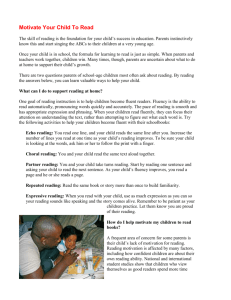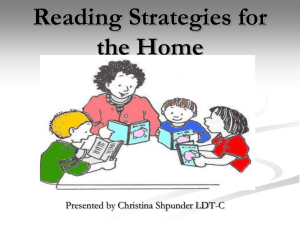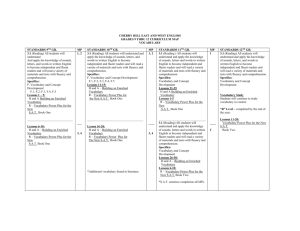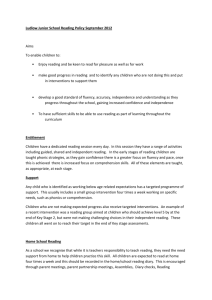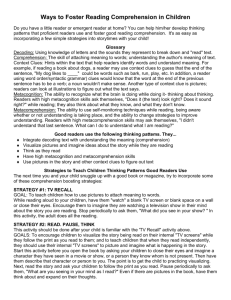Instructional Interventions
advertisement
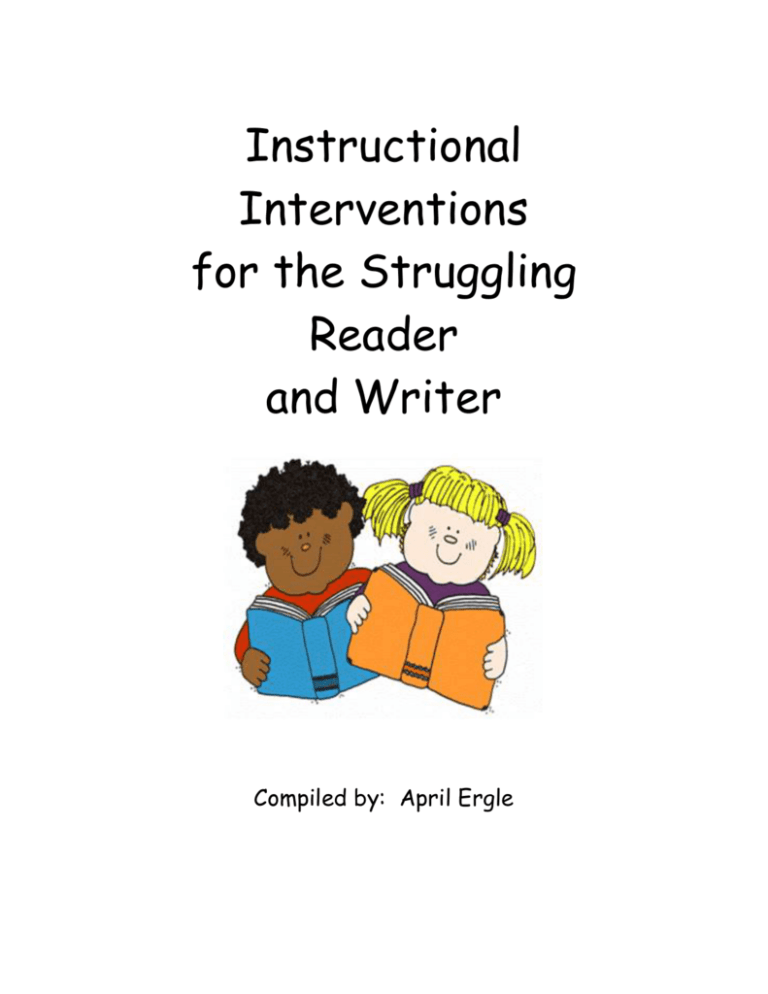
Instructional Interventions for the Struggling Reader and Writer Compiled by: April Ergle If a child has difficulty remembering soundsymbol relationships… • Start with sounds in student's name. • Over teach at an appropriate level, within a context. • Develop anchors or supportive cues such as picture cards for each sound spelling so he/she can associate a letter with an image and a key word. • Make an ABC book, writing only the letters the child recognizes, pasting student selected pictures for each. Child reads on a daily basis: "A a apple, B b ball," etc. Add new letters as the child takes them on. • Move from the known to the unknown: "Do you know a word that starts like that? Now get your mouth ready." • Ask student to say the sound as he writes. • Practice, practice, practice. • Model during interactive writing, shared writing. • Global learners cannot learn sounds in isolation. Teach all phonics- related skills in the context of meaningful words, phrases and sentences. • Include all the senses in learning the sounds. • Raps and rhymes help kinesthetic students learn letter sounds more easily. • Stretch the word like a rubber band. • Use mirrors to demonstrate mouth/tongue/teeth position. If a child lacks knowledge of sight words… • Always take unfamiliar words back to context. • Build word banks of sight words and use them to create sentences or organize by naming or action words. • Practice recognizing similar and confusing words, such as those beginning with th or wh, by circling difference in them on word lists and identifying them on flash cards. • Review common words daily in context and in isolation, teaching the child to use context clues at unknowns. • Say, write, and read words many times to develop automaticity. • Develop knowledge of spelling patterns, root word sight vocabulary, adding common prefixes and suffixes. • "Make and break" words with magnetic letters. • Use multi-sensory techniques (magnetic letters, Elkonin boxes, drawing it in the air, etc.) • Provide opportunities to practice fluency. • Use the analogy approach: seeing similarities and differences among printed words. • Reread predictable books for multiple exposure to highfrequency words. • Implement flexible practice on a regular basis, paying attention to details (ascending and descending letters, length, and configuration). • "Make and break" words with magnetic letters. • Label objects in the classroom using single words or sentences. • Interact with the Word Wall • Highlight high-frequency words in poems, big books, morning message, interactive writing, etc. If a child makes reversals… • Physically guide the child's hand. • Use flexible practice (over teach!). In other words, try to get flexibility by having the child construct the word or letter in different places with a variety of materials such as magnetic letters, Magna Doodle, with chalk, on the carpet, in the air, on a white board, etc. • Sort letters by structure/feature (circles, lines, etc.). • Talk through letter formation. There are commercial programs that provide the "talk," but the ones that teachers, parents and kids make up on their own often seem to work the best for those individuals. Their own language helps as a memory tool. If a child does not use one-to-one matching… • Say, "Read it with your finger." Or "Did that match?" Or "Were there enough words?" Or "Did you run out of words?" • Use two fingers to frame each word. • Point along with the child and stop when he makes an error that could be corrected. • Cut up student generated sentences and reconstruct and read. • Clap oral and written sentences while counting number of words. • Use a variety of pointers: glittered chopsticks, "monster" fingers. • Model 1-to-1. • Write or highlight each word with a different color. • Hold the child's and guide him/her when pointing. • Say: "Read it with your finger." • Ask: "Did that match?" or "Were there enough words?" If a child has difficulty using context clues as a technique of word identification… • Stress the importance of using semantic (context) clues in effective reading comprehension. • Model ways of using semantic and syntactic context clues. • Choose the correct word from several choices to fill in the blank in a sentence and give reasons for the choice. (Jimmy played outside with his [basketball, television, potato, and chair].) • Brainstorm words that would make sense for the unknown word in a sentence and consider phonics clues (especially beginning sound) in deciding on the word (Guess the Covered Word from Pat Cunningham). • Encourage students to supply words that make sense while reading, to become risk takers. • Provide practice in listening for miscues using teacher-read material with intentional errors. Students indicate when the miscues occur and why they are inappropriate. • Teach students to read to the end of the sentence. Words following an unknown usually provide more help than the words before it. It is also helpful to reread the prior sentence and the sentence following. • Reinforce and praise the use of self-correcting in oral reading. If a child does not self-monitor… • Ask the child to go back to one-to-one pointing or tracking. • Direct the child's attention to meaning. • After an error, ask the child: "Where was the hard part?" • When the child hesitates or pauses, ask the child, "Why did you stop?" Or "What did you notice?" Be specific with praise. • Praise efforts at self-monitoring by saying, "I like the way you tried to work that out." • "You read it this way. Does that make sense? Is that the way we talk? Does that look right? Read it again for me." • Cover up word that was misread. "What would you expect to see at the beginning of the word ? Does this word start like that? Read it again." • Model self-monitoring through a think aloud process. If a child fails to decode while reading and/or lacks word attack skills… • Provide time to analyze the word instead of being given the word. • Model and use prompts that lead to developing strategies: What letter sounds do you know in the word? Are there any word parts (chunks) that you recognize in the word? Can you get your mouth ready? What else can you do? Could it be ? • Use picture books, poetry and songs that repeat a phonological element. • Teach the student to scan for and underline known words. • Use quality predictable text as well as decodable texts, depending upon the level and development of the child's phonological processes. • Allow the child ample opportunities to read and reread easy books at an independent level in order to build sight word mastery and facilitate fluency. If a child demonstrates poor comprehension skills… • Develop automaticity and word recognition skills. Comprehension breaks down with poor decoding skills, time lapse, and a slow reading rate (wpm). • Build background knowledge, concept development and oral language skills. Plan direct and vicarious experiences to build schemata, which is necessary for reading comprehension. • Provide instruction in understanding of story schema and story grammars. Expose students to well-formed stories (storytelling and story reading). Read a variety of stories with standard structures, building the ability to predict or anticipate. • Activate student schemata through a teacher "think aloud." • Match books to readers. When reading materials is too difficult, focus is diverted to decoding. • Follow up reading with story frame activities: story summary, important idea or plot, setting, character analysis and comparison. • Model metacognition, prediction checks during reading. • Sequence pictures from story: beginning, middle and end. • Utilize pre-reading strategies and activities: previews, anticipatory guides, and semantic mapping. • Use reciprocal teaching to promote comprehension and comprehension monitoring: predicting, question generating, summarizing and clarifying. If a child cannot make inferences or draw conclusions… • Observe the teacher modeling ways to draw inferences by thinking aloud about clues for meaning. • Look at pictures or collections of objects, find reasonable connections among them, and create stories from them. • Listen to a story and predict what will happen next. • Underline word and phrase clues that lead to making an inference. (What season is it? The snow fell and the streets were icy. It was very cold outside.) If a child reads word by word, uses incorrect phrasing or lacks fluency… • Make sure that you have a strong understanding of fluency and the role it plays in comprehension. • Modeling: the teacher and fluent readers are both good models. Commercial or teacher-made story tapes also serve this purpose. • Echo reading: the student imitates the teacher's oral rendition, one sentence or phrase at a time. • Choral reading: less fluent readers are grouped with fluent readers as they read a selected passage in unison. The teacher either reads with the group or serves as a conductor. This is a real confidence builder and at risk readers will feel safe enough to take risks in reading. • Reread easy books, songs, poems. • Neurological impress: the teacher, aide, or volunteer reads slightly ahead of, and louder than, the student. As the student gains fluency, the teacher's voice becomes softer and "shadows" (comes just behind) the student's. This is a highly effective technique, especially good with students acquiring English • Use familiar reading on a daily basis. Each child should have a personal basket or box of familiar texts to read as part of their seatwork during your guided reading period. Journals may also be considered as familiar text. Repeated reading of text that they have mastered during guided reading increases reading rate.


